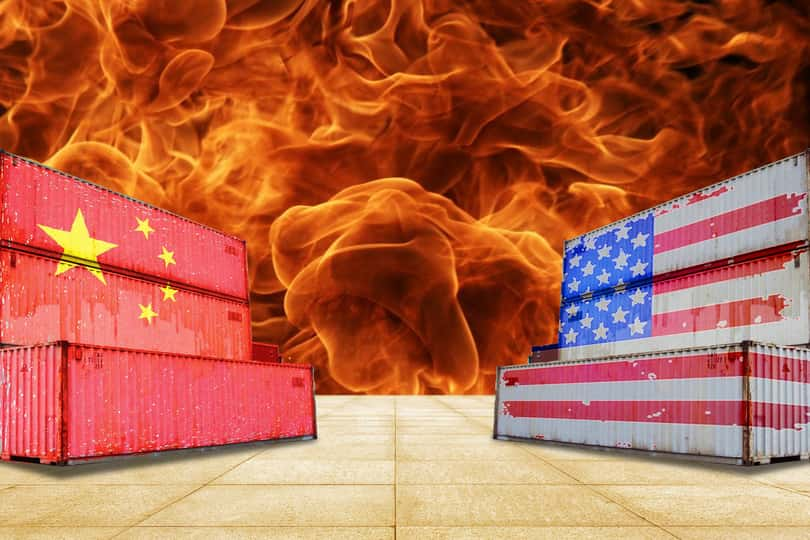Stocks fell 1% from peak to valley on Friday after just 1 minor headline. That being how a Chinese trade delegation cut their US visit short and won’t be visiting farms in Nebraska.
So if stocks fell that far, that fast on this light piece of news…then just imagine how bad it would be if no trade deal came together.
We need to plan for this scary possibility now. Because if you wait for it to unfold, then you will be behind the curve and likely overreacting in the midst of a panicked sell off.
The Immediate Reaction
We all know stocks will tumble when the news first comes out. Just look back at the script from the last time the trade negotiations hit a rough patch. Stocks fell from 3013 intraday on August 1st to a low of 2822 just two short trading sessions later.
Let’s clarify something. That 6% sell off happened to the S&P. The index of the largest, safest stocks. So those of you with a bit more risk in your portfolio saw losses closer to 10%.
There is virtually nothing you can do after the fact. This is the type of event you need to be prepared for in advance.
One solution is to have some money in cash. And the other is to have some inverse ETFs in your portfolio that act as downside protection insurance policies.
Yes, both of these strategies would mean a touch less upside if the deal comes together and the market leaps ahead. But for those who appreciate that the market usually falls about 2X as fast as it climbs…then the risk/reward of being a touch more defensive into this event makes a lot of sense.
And Then What Happens?
There is a pretty wide range of outcomes from this point forward. So let’s tackle them one by one.
Worst Case Scenario = Bear Market: There are more and more signs of an economic slowdown already happening. Everything from a 5% contraction in business investment that appeared in Q2 GDP. Or the sub-50 ISM Manufacturing reading from early October. The main culprit in this is concerns over the China Trade deal.
So it is fair to assume that the deal breaking down could have businesses pulling back harder on spending which degenerates into the next recession and bear market.
Since the average bear market brings with it a 34% decline in stock prices, then the game plan is very easy. Sell EVERY stock. Short the market with inverse ETFs. Then start looking for spots to get long for the next bull market 6-12 months down the road.
Best Case Scenario = Raging Bull Market: Here we find that the snafu in trade negotiations is quickly resolved and a deal is finally forged. The market reacts by pressing to new highs. And the economy picks up pace with this dark cloud finally removed.
The trading strategy would be to take more risk like small and mid cap growth stocks. Or even pick up some of the best Chinese companies trading at steeper than normal discounts. Or even simpler, just get back to the riding the bull in similar fashion as you have the majority of the past 10 years.
Middle Case Scenario = Sluggish Bull Market: Perhaps the deal doesn’t come together…and we don’t fall into recession either. We just have a slower growth economy. But because bond rates will most certainly come down during the initial Risk Off market reaction…that stocks will become all the more attractive by comparison.
I am referring to our previous conversations on how the market favors stocks over bonds especially when the dividend yield on stocks is greater than that of Treasury bonds (read more about that here: Does 1 Equation Hold the Key for Stock Prices?)
This scenario is like going back to the late August stock market. That’s where investors had a Flight to Safety movement that focused on large cap, income producing stocks in defensive industries like Utilities, Healthcare and Consumer Staples. This kept the S&P 500 aloft while the small and mid cap indices suffered.
My Recommendation
As you can see there are a wide range of outcomes. But that doesn’t mean we should put our heads in the sand either. We need to take action of some kind.
I have always liked the idea of finding a balance between the best and worst case scenarios. This way you are never caught off guard. And from that position it is easier to get more defensive or more aggressive depending on how things unfold.
That balancing act translates into being only 70% long the stock market at this time. I am using inverse ETFs to make that happen as they will also rise dramatically if this deal falls apart.
Sure I still have a healthy serving of aggressive growth/value stocks in the portfolio. However, I am trying to limit exposure to China. While also have an ample portion of conservative income producing stocks that are doing fine now, but would certainly weather any market storm much better than most stocks.
In all I have 10 stocks + 1 long ETF + 2 inverse ETFs in the Reitmeister Total Return portfolio. I invite you to discover all these current selections by starting a 30 day trial.
Discover the Reitmeister Total Return portfolio
Wishing you a world of investment success!

Steve Reitmeister
…but my friends call me Reity (pronounced “Righty”)
CEO, Stock News Network
Editor, Reitmeister Total Return
SPY shares . Year-to-date, SPY has gained 20.46%, versus a 20.46% rise in the benchmark S&P 500 index during the same period.
About the Author: Steve Reitmeister

Steve is better known to the StockNews audience as “Reity”. Not only is he the CEO of the firm, but he also shares his 40 years of investment experience in the Reitmeister Total Return portfolio. Learn more about Reity’s background, along with links to his most recent articles and stock picks. More...
More Resources for the Stocks in this Article
| Ticker | POWR Rating | Industry Rank | Rank in Industry |
| SPY | Get Rating | Get Rating | Get Rating |
| Get Rating | Get Rating | Get Rating | |
| Get Rating | Get Rating | Get Rating | |
| Get Rating | Get Rating | Get Rating | |
| Get Rating | Get Rating | Get Rating |






